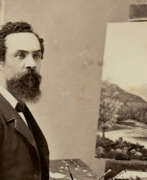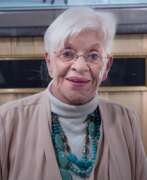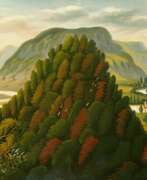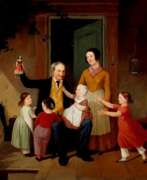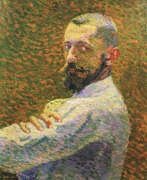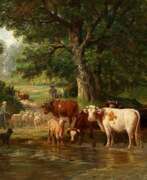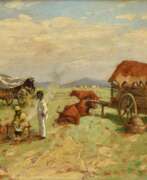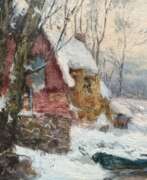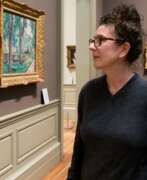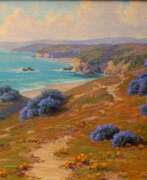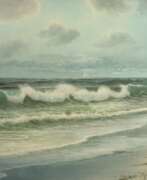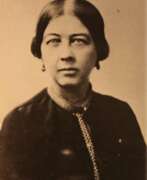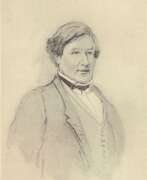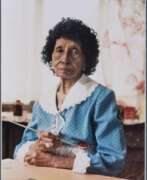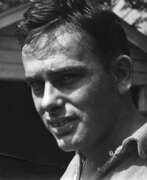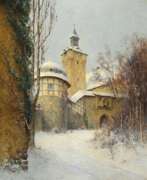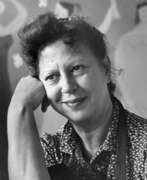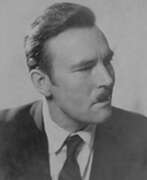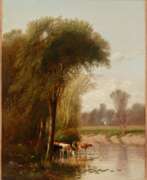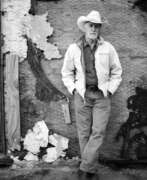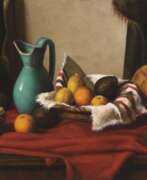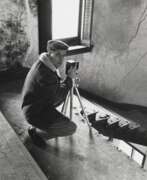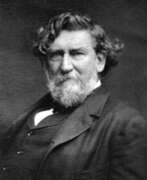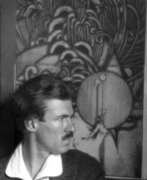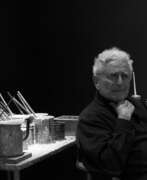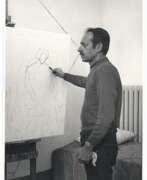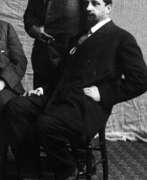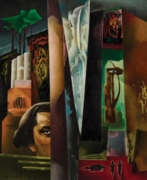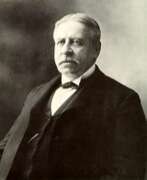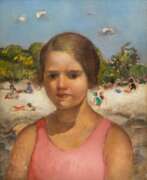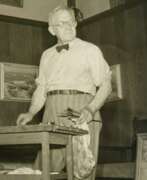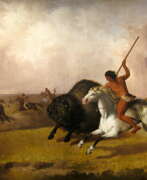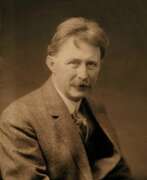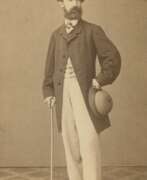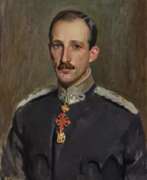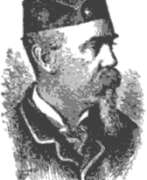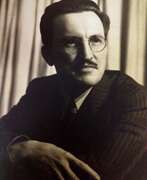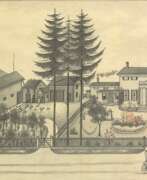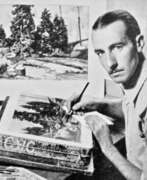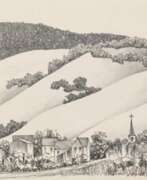Rural landscape USA
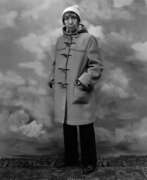

Berenice Alice Abbott was an American photographer best known for her portraits of between-the-wars 20th century cultural figures, New York City photographs of architecture and urban design of the 1930s, and science interpretation in the 1940s to 1960s.
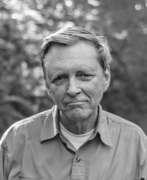

Robert Adams is an acclaimed American photographer known for his profound exploration of the American West's changing landscapes. His work, which gained prominence in the mid-1970s, delves into the tension between the natural beauty of the land and the marks of human encroachment. Adams's photography is a reflection on humanity's relationship with the environment, offering both a critique and a celebration of the landscape.
Robert Adams's notable series, such as "Turning Back" and "The New West," showcase his unique perspective on environmental and urban development issues. His work extends beyond just capturing images; it is a thoughtful commentary on the balance between nature and industrialization. His photographs, often devoid of people, focus on the land itself, telling a story of alteration and resilience.
Exhibitions of Adams's work, such as "American Silence: The Photographs of Robert Adams" at the National Gallery of Art, provide insight into his 50-year career and his ability to capture the silent yet profound narratives of the American landscape. His pieces are part of major collections and have been featured in numerous retrospectives, underlining his influence and significance in the world of photography.
For art collectors and enthusiasts, Robert Adams's work offers a poignant perspective on the American West, blending aesthetic beauty with critical environmental commentary. Engaging with his work invites reflection on our interaction with the landscape and our role in shaping the environment.
If you're interested in staying updated on Robert Adams's work and exhibitions, consider subscribing to newsletters from galleries and museums that feature his art. This way, you'll be informed about new displays of his work and opportunities to engage with his insightful perspectives on the American West.
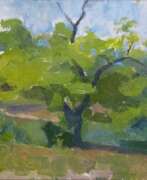

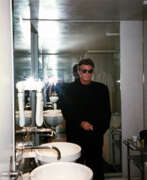

Lewis "Duke" Baltz was an American visual artist, photographer, and educator. He was an important figure in the New Topographics movement of the late 1970s. His best known work was monochrome photography of suburban landscapes and industrial parks which highlighted his commentary of void within the "American Dream". His work is focused on searching for beauty in desolation and destruction. Baltz's images describe the architecture of the human landscape: offices, factories and parking lots. His pictures are the reflection of control, power, and influenced by and over human beings. His books and exhibitions, his "topographic work", such as The New Industrial Parks, Nevada, San Quentin Point, Candlestick Point, expose the crisis of technology and define both objectivity and the role of the artist in photographs. He wrote for many journals, and contributed regularly to L'Architecture d'Aujourd'hui. Baltz's work is held in the collections of the Solomon R. Guggenheim Museum, Metropolitan Museum of Art, Tate Modern, Los Angeles County Museum of Art, Whitney Museum of American Art etc.
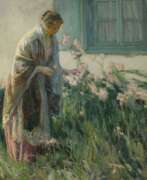

Myron G. Barlow was an American painter and illustrator known for his genre scenes, portraits, and landscapes. He was began his artistic training at the Art Institute of Chicago. Later, he studied at the Académie Julian in Paris, where he was influenced by the Impressionist and Post-Impressionist movements.
Barlow worked as an illustrator for various publications, including Harper's Weekly, Scribner's Magazine, and The Saturday Evening Post. He also taught at the Art Students League in New York City.
Barlow's paintings often depicted everyday life, with a focus on working-class people and their surroundings. His use of color and light gave his paintings a sense of warmth and intimacy.
Barlow was a member of several art organizations, including the National Academy of Design, the Society of American Artists, and the American Watercolor Society. He received numerous awards and honors during his lifetime, including a gold medal at the Panama-Pacific International Exposition in San Francisco in 1915.
Today, his paintings can be found in several museums and institutions, including the National Gallery of Art in Washington, D.C., and the Brooklyn Museum in New York City.


Theodore Butler was an American Impressionist painter who is best known for his depictions of the French countryside.
Butler studied at the Art Students League of New York and worked as an illustrator for publications such as Harper's Weekly and Scribner's Magazine. In 1887, he traveled to France to study at the Académie Julian in Paris. There, he met the Impressionist painter Claude Monet and became part of his inner circle of friends and collaborators. Butler eventually settled in the village of Giverny, where he lived for the rest of his life.
In Giverny, Butler painted landscapes and scenes of everyday life in the countryside, often featuring the gardens and water lilies made famous by Monet's own paintings. He developed a loose, painterly style that was influenced by the Impressionists but also showed the influence of Post-Impressionism.
Today, Butler's work can be found in the collections of museums such as the Metropolitan Museum of Art in New York City, the Musée d'Orsay in Paris, and the Art Institute of Chicago. His contributions to the development of Impressionism and his association with Monet continue to make him an important figure in the history of art.
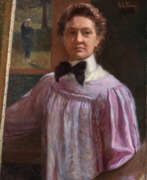

Lilla Cabot Perry, birth name Lydia Cabot Perry, is an American impressionist painter.
Lydia Cabot Perry began painting after her marriage and the birth of her children. Some time spent in Japan and France, where she painted a lot. After meeting Claude Monet, which took place in 1894, the artist sharply changes his style and technique of image. Among other genres, she favoured landscape painting.
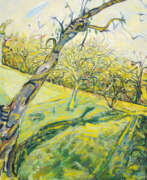

Bernard Chaet was an American artist. Chaet is known for his colorful, dynamic modernist paintings and masterful draftsmanship, his association with the Boston Expressionists, and his 40-year career as a Professor of Painting at Yale University. His works also include watercolors and prints. In 1994, he was named a National Academician by the National Academy of Design. Chaet's works are in the permanent collections of many important museums. Chaet is known for his association as a first generation Boston Expressionist. Having studied with Zerbe, a father of Boston Expressionism, Chaet's early works certainly adhere to the techniques and philosophy of the school.
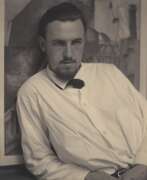

Konrad Cramer was a German-born American painter. He was trained at the Academy of Fine Arts in Karlsruhe, and he emigrated to the United States in 1911. A naturalized U.S. citizen, he is "often credited as being an important link between German and American modernism in art."


Adolf Dehn was an American artist known mainly as a lithographer. Throughout his artistic career, he participated in and helped define some important movements in American art, including regionalism, social realism, and caricature. A two-time recipient of the Guggenheim Fellowship, he was known for both his technical skills and his high-spirited, droll depictions of human foibles. In the 1930s, his work began to appear in magazines such as The New Yorker and Vogue. During his period as a lithographer, his striking images of New York, including Central Park, captured the essence of the Roaring 20s and the 1930s Depression. Beginning in 1930, Dehn executed a significant number of drawings and lithographs based on Midwest scenes. In the early 1930s, Dehn established The Adolf Dehn Print Club and became a founding member of the Associated American Artists. Dehn started executing watercolors in late 1936. Watercolor painting and casein painting represented signature second and third arms of Dehn's artistic output for the rest of his career. He is remembered as a prolific artist of great range. His works are held in over 100 museums. Dehn had a distinct style of illustration and painting. His drawings exhibit freedom in line and form along with social satire. Dehn's landscapes suggest the grandeur of nature, and a signature element in them for which Dehn was praised was the magnificence of his clouds.
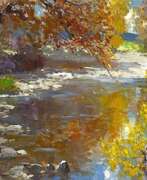

Fremont F. Ellis was an American impressionist painter who expressed a deeply intuitive perception of nature in his works.
He painted in a style strongly influenced by the Impressionists, using bold strokes and vivid colours to convey light and atmosphere in his landscapes. Being self-taught, he joined a well-known group of young Santa Fe artists, Los Cincos Pintores. For nearly 70 years Ellis drew inspiration from the beauty of New Mexico's landscapes.
Ellis' work continues to influence contemporary artists. His work has been exhibited in many galleries in New York, London and Paris. Ellis received many prestigious awards during his career, including the Julian Medal and the Gold Medal at the Paris Salon in 1930. His work is held in several museums, including the Harwood Art Museum in Taos, New Mexico, and the National Museum of American Art in Washington, D.C.
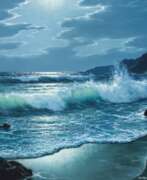

Anton Gutknecht was a German-American landscape painter known for his maritime seascapes of southern California and rural Europe. With a particular interest in the tumultuous nature of the ocean, the artist often focused on capturing waves crashing on the shore or on the boughs of a ship rendered in a high level of realistic detail. Gutknecht spent his early life traveling between different areas of the country, notably Munich and Hamburg, observing the mountainous terrain that would later be the focus of his work and bring him recognition. Gutknecht taught at the Royal Academy in Vienna before frequently traveling to southern California in the 1930s, eventually moving there to settle in Palm Springs and focus on capturing the landscape there.
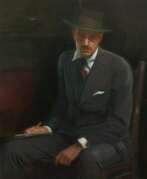

Ernest Martin Hennings (Jr.) was an American artist and member of the Taos Society of Artists. In 1901 that Hennings began taking classes at the School of the Art Institute of Chicago, which was largely based on the great European art schools and made particularly emphasis on the importance of drawing. Hennings took up work as a commercial artist, mostly painting murals and portraits around Chicago. Hennings' primary interest was in portrait painting, with his primary subject being the Native Americans living in and around Taos Pueblo. In 1922 he was awarded the Clyde M. Carr Prize from the Art Institute of Chicago as well as the Institute's Fine Arts Building Prize. By the 1920s, the now established painter was building his reputation on the national scene, with exhibitions and awards including. Many art collectors throughout America sought out his paintings. Today paintings by Hennings are housed in the Smithsonian American Art Museum, Stark Museum of Art, Booth Western Art Museum etc.

Aldro Thompson Hibbard was an American artist known for his depictions of rural New England landscapes.
Hibbard studied at the School of the Museum of Fine Arts in Boston and later at the Académie Julian in Paris. He became a prominent member of the Rockport Art Colony in Massachusetts, where he spent most of his career teaching and painting.
Hibbard's paintings were primarily landscapes, often featuring snow-covered hills, barns, and farmhouses. He painted in a realist style, with an emphasis on the effects of light and atmosphere on the New England countryside. Hibbard was also an accomplished etcher, and his prints often depicted similar subjects to his paintings.
Today, Hibbard's work can be found in the collections of museums such as the Smithsonian American Art Museum in Washington, D.C., and the Museum of Fine Arts in Boston. He is considered an important figure in the development of American landscape painting, and his depictions of rural New England continue to be celebrated for their beauty and realism.
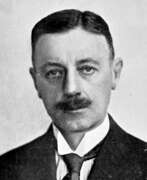

William Victor Higgins is an American artist. He is known for his landscape paintings and is considered one of the most important representatives of the Taos Society of Artists. He studied painting at the Chicago Academy of Fine Arts and at the Académie Julian in Paris with Robert Henri, René Menard and Lucien Simon.
William Victor Higgins often depicted the rugged landscapes and Indians of the American Southwest in his paintings. He was particularly interested in Native American culture and often painted portraits of them. His work is characterized by bold strokes and vivid colours.
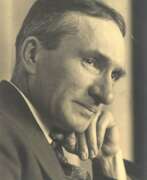

Holmead, born Clifford Holmead Phillips, was a painter. From about 1920 he joined various artist colonies in New England. In 1923, some of his paintings were shown for the first time as part of an Art Association exhibition. They were delicate, airy idylls, traditional landscapes in a brittle, silvery light, lonely farmhouses and trees. But he found the painting practiced there to be too beautiful and looked for new inspiration. In Paris, seeing a work by the French Expressionist and Fauvist Maurice de Vlaminck caused a fundamental change in his view of art. Vlaminck's dynamic lines and strong colors impressed Clifford Holmead Phillips so much that he increasingly followed the expressive direction, but later defined his style as "Crude Expressionism". From the 1920s to 1940, he celebrated international success and exhibited in important galleries and museums on both continents.


Carl Thomas Hoppe (1897-1981) was a notable South Texas artist, born in San Antonio, Bexar County, Texas, to German immigrant parents, August and Teresa Hoppe. Despite his primary occupation as a salesman for Joske's Department Store in downtown San Antonio from where he retired in the 1970s, Hoppe was recognized for his significant contributions to the art scene, particularly from the early 1900s through the 1960s. His work gained renewed interest and appreciation in the late 20th and early 21st century.
Hoppe was primarily known for his landscapes, characterized by an impressionistic style. He began painting in his youth and later honed his skills under the guidance of José Arpa y Perea. His paintings were exhibited at various notable locations, including the Witte Museum in San Antonio. He was part of a vibrant community of artists and often went on field trips with Julian Onderdonk, a prominent figure in Texas art. Moreover, his association with other leading artists of the state, such as Porfirio Salinas and Robert William Wood, further cemented his place in the Texas art world.
Hoppe's artworks have been featured in several exhibits, including at the River Art Group's River Art Gallery in San Antonio, and in 1997, a special exhibit of his works was held at the Panhandle-Plains Historical Museum in Canyon, Texas.
His signature on his paintings, "C. Hoppe," and the occasional inclusion of a brief descriptive phrase on the back of his paintings or on a paper label, gave a personal touch to his works. Some of his original frames appear to be home-crafted, adding a unique element to his pieces.
Today, Carl Hoppe's paintings are highly sought after and are sold by leading Texas galleries such as David Dike Fine Art in Dallas and William Reaves / Sarah Foltz Fine Art in Houston. His works, which capture the essence of South Texas landscapes with an impressionistic flair, continue to be celebrated and are a valuable part of American art history.
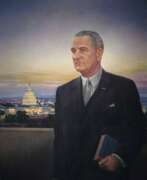

Peter Hurd was an American painter whose work is strongly associated with the people and landscapes of San Patricio, New Mexico. He is equally acclaimed for his portraits and his western landscapes. His large egg tempera paintings earned him national recognition. During World War II, Hurd worked for Life magazine as a war correspondent attached to the US Air Force. He covered almost all the fronts of the far-flung battle line, creating hundreds of "War Sketches" that range from poignant to comic. Some of Hurd’s most well-known portraits were of his neighbors, family, and friends at Sentinel Ranch. He loved to paint people who were deeply connected to the land, and always showed them outdoors, against the hills and sky. Many of Hurd's works can be seen at the Hurd-La Rinconada Gallery in San Patricio, New Mexico.
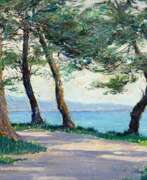

Constance Jenkins Macky was an Australian-born American artist and teacher. She was known for her portraits, landscape paintings, and still life paintings. She was a member of the San Francisco Art Association, and the California Society of Women Artists.
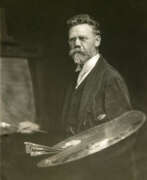

Robert Koehler was a German-born painter and art teacher who spent most of his career in the United States. Koehler was born in Hamburg; his family moved to Milwaukee, Wisconsin in 1854. There he attended the historic German-English Academy. He apprenticed himself to a lithography firm. In 1871, he went to New York City and stayed to work as a lithographer. After studying drawing in the night classes of the National Academy of Design, Koehler went to Munich to study fine art at the Royal Academy in 1873. In 1879, he was able to return to Munich. Koehler's work while in Munich won him silver and bronze awards from the Academy, and Bavaria's Cross of the Order of St. Michael. Koehler then set himself up as head of a private art school. He began to exhibit in the National Academy, New York, in 1877. In 1885 he took charge of a private school of art in that city. He organized the American department of the international art exhibition at Munich in 1883, and was appointed by the Bavarian authorities to act in the same capacity in the exhibition of 1888. In 1892 Robert Koehler returned to New York City to work as a portrait artist. The following year he moved to Minneapolis, Minnesota, accepting an offer to be the director of the Minneapolis School of Fine Arts (now the Minneapolis College of Art and Design). Koehler was also involved with the establishment of Minneapolis' Museum of Fine Art, now the Minneapolis Institute of Arts. He was a pioneer of art instruction and appreciation in the region. Koehler continued working in Minneapolis, painting portraits and landscapes, teaching painting, and arranging exhibitions. He retired as director in 1914.


Leon Kroll was an American painter known for his landscapes, portraits, and figure paintings. He was born in New York City and studied at the Art Students League and the National Academy of Design.
Kroll's early works were influenced by the Ashcan School, which focused on depicting the grittiness of urban life. However, he eventually turned to painting landscapes and became known for his depictions of the Adirondack Mountains and the coast of Maine.
Kroll also produced a large number of portraits, including those of prominent figures such as President Franklin D. Roosevelt and Supreme Court Justice Felix Frankfurter.
Kroll was a member of several art organizations, including the National Academy of Design, the American Academy of Arts and Letters, and the American Watercolor Society. He received numerous awards during his career, including the National Academy of Design's Altman Prize in 1922.
Today, Kroll's works can be found in several museums and collections, including the Metropolitan Museum of Art, the Smithsonian American Art Museum, and the Museum of Fine Arts, Boston.
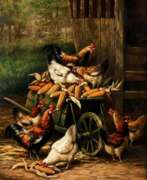

August Laux was a painter and designer of French origin who worked in Germany and the United States.
In 1863 he emigrated with his parents from Germany to New York, where he studied sculpture and painting, then enrolled in courses at the National Academy of Design. In the 1870s he was commissioned to paint sets for a private club theater in Manhattan. After a successful result, Laux's work became in demand in wealthy homes and hotels.
In painting, Laux took on different genres: he painted floral and fruity still lifes, genre animalistic scenes, and rural landscapes.
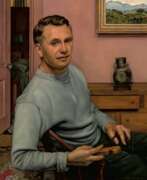

Luigi Lucioni was an Italian-American painter known for his still-lifes, landscapes and portraits. He emigrated to the United States in 1911 and studied art at Cooper Union in New York.
Luigi Luccioni's style was influenced by Renaissance painting techniques, and he often used the glazing method to create vivid and detailed images. He was a member of the National Academy of Design and won many awards during his career.


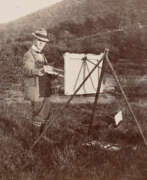

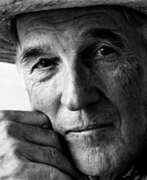

Dale William Nichols was an American landscape painter whose work included illustrations, paintings, lithographs, and woodcarvings. His favorite subject is rural landscapes, often snow-covered. Nichols' paintings are represented in many public and private collections across the country, including the Art Institute of Chicago. His most famous oil painting, End of the Hunt, hangs in the Metropolitan Museum of Art.


Abigail May Alcott Nieriker was an American artist, sister of the famous writer Louisa May Alcott. Engaged in painting and sketching.
Abigail Nieriker's works are mainly landscapes, still lifes and portraits. The artist had a keen sense of the beauty of nature and the nuances of everyday life. Her paintings and sketches were characterised by fine taste, attention to detail and a sense of harmony.
In addition to her artistic endeavours, Abigail Nyeriker was also a writer and published essays and short stories in various publications. She shared her views on topics such as education, women's rights and social issues of the time. Her writings often reflected her progressive views and her desire for social justice.


Fairfield Porter is an American artist known for his realistic paintings depicting his family, friends, and the natural environment. Porter began his career as an abstract painter, but later switched to a realistic style. His work is notable for its vibrant colors and his ability to convey the atmosphere and mood of his subjects. He is also known for his landscapes, including seascapes, which often depict his native Maine. Porter was also a professor at Stony Brook University in Manhattan and wrote several essays and articles on art. His work can be seen at the Museum of Modern Art in New York, the Metropolitan Museum of Art and the National Gallery of Art in Washington, DC.


William Trost Richards was an American landscape artist. He was associated with both the Hudson River School and the American Pre-Raphaelite movement.
In the 1870s, he produced many acclaimed watercolor views of the White Mountains, several of which are now in the collection of the Metropolitan Museum of Art. Richards exhibited at the National Academy of Design from 1861 to 1899, and at the Brooklyn Art Association from 1863 to 1885. He was elected a full member of the National Academy in 1871.
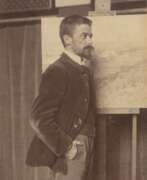

Theodore Robinson was an American painter best known for his Impressionist landscapes. He was one of the first American artists to take up Impressionism in the late 1880s, visiting Giverny and developing a close friendship with Claude Monet. Several of his works are considered masterpieces of American Impressionism.
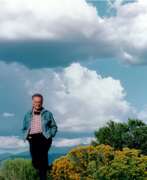

Eric Sloane (born Everard Jean Hinrichs) was an American landscape painter, illustrator, and author.
Sloane was an accomplished artist who painted in a traditional, realistic style. He was particularly known for his depictions of the American landscape, often featuring rural scenes and historical structures such as barns and covered bridges. In addition to his painting, Sloane was also a prolific illustrator, working on books, magazines, and advertising campaigns.
Sloane was also a respected author, writing books on topics such as American history, weather lore, and traditional building techniques. He was a proponent of preserving traditional crafts and building methods and wrote extensively on the subject.
Today, Sloane's work can be found in the collections of museums such as the Smithsonian American Art Museum in Washington, D.C., and the New Britain Museum of American Art in Connecticut. His legacy continues to be celebrated by those who appreciate his contributions to American art and culture.
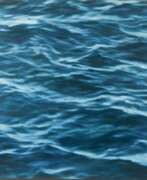

Clifford Smith is an American landscape painter.
Smith studied at Southern Connecticut State College and the Pratt Institute, Brooklyn. He has had numerous solo exhibitions since the late 1970s and has also participated in group exhibitions across the country.
Clifford Smith's works appear at first glance to be photographs, so realistically are they painted. Whether depicting ocean expanses or urban and rural landscapes, the artist conveys the tension and sensuality of nature.
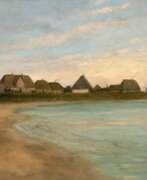

Julius Stockfleth was a Denmark-born painter of landscapes and marine subjects, who settled in Galveston in 1885 and painted the city's docks, harbor, and ships. He created a series of paintings documenting the city during the 1900 hurricane and its subsequent rebuilding, which are the only known contemporary paintings of the disaster. Stockfleth left some 100 paintings of Texas subjects painted in a naïve realist style. After living in Galveston for two decades, he returned to Germany in 1907 and painted local scenes until his death. His work is in the collection of the Rosenberg Library.
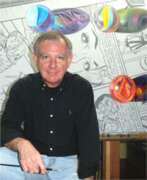

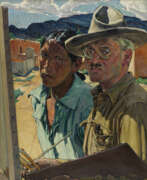

Walter Ufer is an American illustrator and muralist. He received his formal art education in Hamburg and Dresden, where he befriended the American artists Joseph Henry Sharpe and Ernest Blumenschein. In 1906, Ufer moved to Taos, New Mexico, where he became part of a group of painters known as the Taos Society of Artists.
Walter Ufer was drawn to the rugged landscape of the American West and the culture and daily life of the Pueblo Native Americans. Ufer's paintings are characterized by vivid colours and a free-spirited style of painting, conveying the energy and movement of his subjects. He often paints scenes of hunting, horseback riding and other outdoor activities.
Ufer's work was widely acclaimed during his lifetime and he received many awards for his paintings.


Hermann Urban was an American-born German artist best known for his elegiac paintings of ruins. He studied at the Royal Academy of Arts in Munich. Urban dealt with landscape painting in Neubeuern. In 1886, Urban opened his first studio in Munich's Amalienstrasse. Urban spent the period from 1892 to 1894 in Italy, and in 1894 he became a student of Arnold Böcklin in Florence. In 1897 Urban became a member of the Luitpold Group. In 1918 he was elected chairman of the artists' council in Munich. From 1939 to 1944, Urban was represented at all the Great German Art Exhibitions in Munich with a total of 23 paintings that appealed to the tastes of leading Nazis. His scenes are often situated in picturesque landscapes, rendered in a unique style that hybridizes Realism and Impressionism.
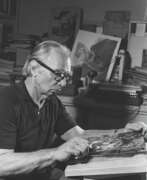

Lynd Kendall Ward was an American artist and novelist, known for his series of wordless novels using wood engraving, and his illustrations for juvenile and adult books. His wordless novels have influenced the development of the graphic novel. Although strongly associated with his wood engravings, he also worked in watercolor, oil, brush and ink, lithography and mezzotint. His best-known books are Gods' Man and his Caldecott-winning children's story, The Biggest Bear.




